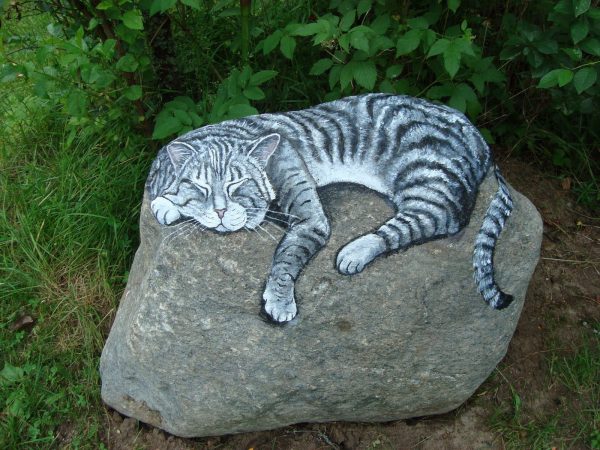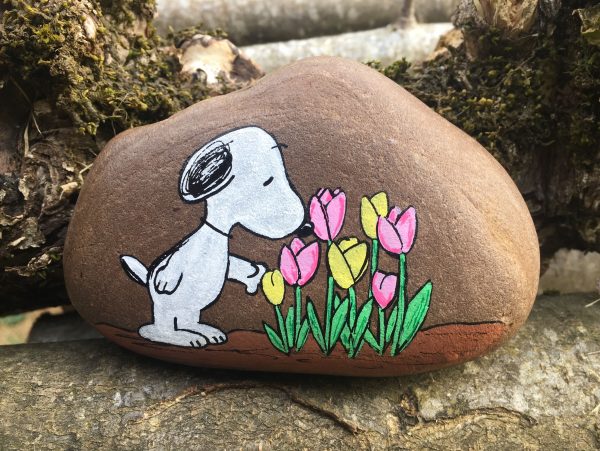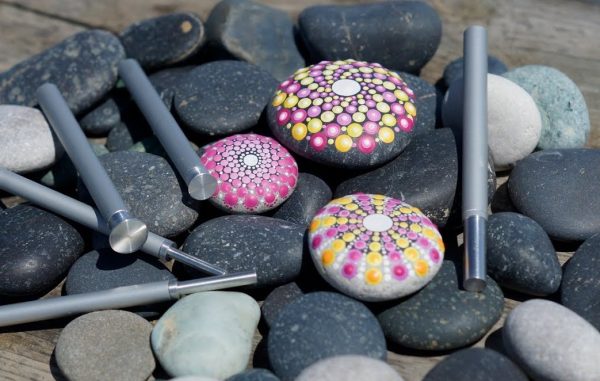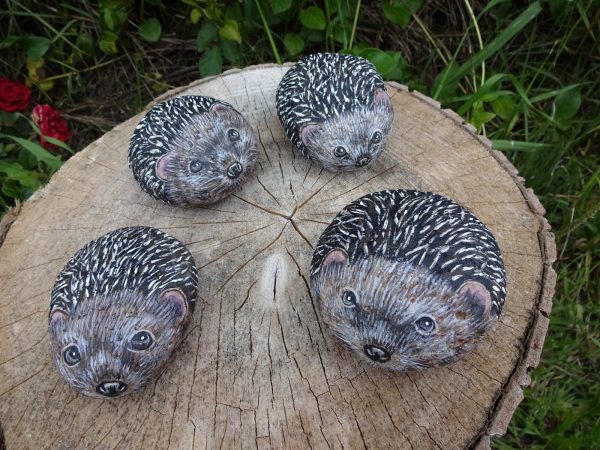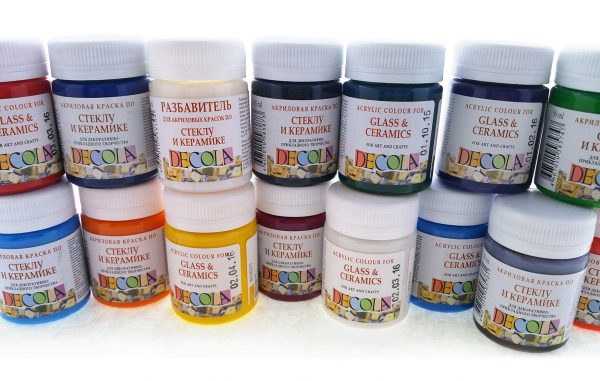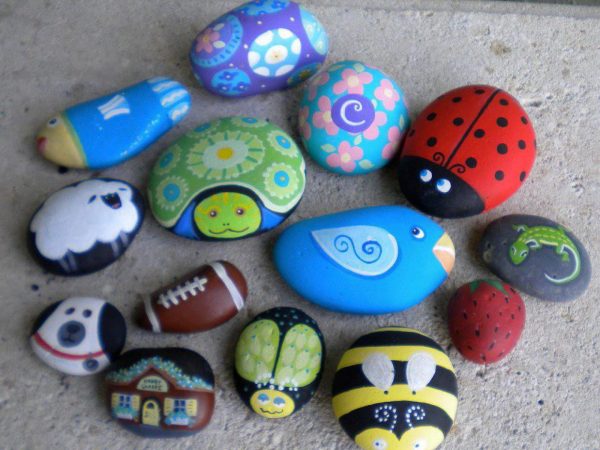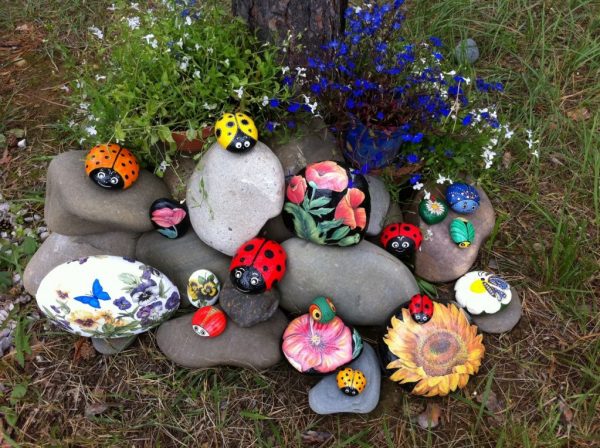Ancient people used drawings on stones - these were the first cave paintings. Now, in contrast to modern gadgets and plastic crafts, the use of natural resources in garden design is gaining more and more popularity.
- Drawing methods
- How to choose stones
- Making artificial stones
- Pattern selection
- Materials required for painting
- Paints
- Contours, felt-tip pens, pencils
- Brushes
- Lacquer
- How to build a palette
- Painting sequence
- What can be painted on the stone?
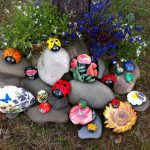
Painting on stones is often used by designers to decorate country houses, summer cottages, mantelpieces and pools. Such a hobby allows adults and children to show creative artistic abilities.
Drawing methods
To make the area around the house pleasing to the eye with design, it is not necessary to pay expensive. You can decorate it with your own hands, using imagination, a sense of humor and a minimum of supplies. You do not need to be a professional artist. Stone compositions are often made in the form of animals, toys, natural objects. In order for the images to look believable and aesthetically pleasing, to delight their owners for a long time, it is necessary to use the correct painting methods. Large stones can be smeared with a roller or simply immersed in paint to get a uniform monophonic layer, later used as a background.
There are several proven methods for applying color to stones:
- decoupage;
- double stroke technique;
- application of patterns.
The most popular painting technique is decoupage. To design a stone, a pattern or ornament is glued to it, which:
- cut out of a napkin;
- laid face down on a piece of cellophane;
- ironed with a hot iron;
- soaked in cold water;
- smoothed on the surface of the stone;
- dried up.
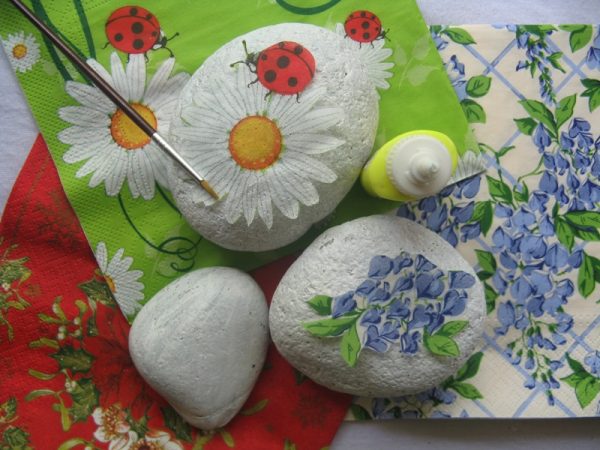
Then the resulting composition is varnished so that it lasts longer. This method allows you to get a high-quality image even to those who have never before been involved in artistic creation.
For those who know how to handle brushes and paints and have the ability to paint, the second method is suitable. The technique is based on the simultaneous application of several colors, giving a dual effect. For example, colorful flower petals are obtained by combining red with pink or lilac with purple.
Using stencils also allows you to get a good result. Pictures can be cut from children's coloring books, old magazines or downloaded from the Internet. The carved figure is circled on the surface of the stone with a simple pencil and painted with acrylic, watercolor or gouache, and then varnished. You can use spray paints.
Some masters come up with their own ways of painting stones.
to contents ↑How to choose stones
The best option for decorating the garden - sea pebbles of the correct form, polished by the waves. It does not have to be pre-treated with PVA glue. Usually light smooth stones are selected to create a neat, clear pattern so that the paint lays evenly. They should be small in size with a flat base, so that they are conveniently installed stably on the site.
to contents ↑In some cases, a porous material that absorbs pigment well is more suitable. For volumetric compositions, you can find large stones directly on the site. Depending on the design, not only ideally smooth, but also complex geometric shapes are useful for realizing fantasies.
Making artificial stones
Sometimes creative imagination goes beyond natural possibilities. In the absence of the necessary material for the invented painting, the basis for the drawing can easily be done with your own hands. To do this, you need:
- fill the container (bucket or basin) with river sand;
- moisten it with water;
- pit manually in wet sand the size required for the stone;
- cover it with polyethylene;
- knead standard cement mortar;
- add dye of the desired color to it (if necessary);
- put the mixture into the prepared form;
- cover with cellophane and cover with a layer of sand so that the cement does not crack.
After final drying, you can get the workpiece and proceed with the scheduling using conventional technologies.
to contents ↑Pattern selection
The plot of the image on the stones depends entirely on imagination and artistic abilities: from the simplest children's pictures to the most complicated paintings made using the point technique. The image is selected in accordance with their own aesthetic taste and creative skills. You can copy the picture on the Internet or create an original sketch. First of all, it is thrown on paper in full size, then with the help of contour pencils it is transferred to a stone in order to simplify its work.
All sorts of images applied in bright colors look spectacular:
- vignettes and ornaments;
- fruits and berries (strawberries, watermelons);
- flowers
- mushrooms;
- animals (owl, hedgehog, turtle, snake, worms, caterpillars);
- insects (bee, ladybug, butterfly, dragonfly);
- fish;
- gnomes;
- houses
- game plots.
to contents ↑Images of animals require some artistic skills. You can watch a virtual thematic drawing lesson on the Internet.
Materials required for painting
The colorfulness, expressiveness and durability of the drawings on the stones depend not only on the chosen basis, but also on the quality of the resources used. Before you begin, you need to stock up on everything you need. Pre-treatment of stones consists in applying a primer layer: this way the paint will lie evenly and its consumption will decrease. For a light foundation, this step can be skipped. The most significant elements of the upcoming painting are pigments and brushes.
to contents ↑Paints
The best resource for decorating stones is acrylic paints, although artists can use a variety of compositions. Using a product for applying to ceramics and utensils is convenient, but requires financial costs and heating in an oven for greater strength. Watercolor and gouache have a watery consistency, crack under the influence of the sun, and are easily washed off by moisture. Acrylic is characterized by sufficient density, allowing it to evenly, without smudges, cover the surface the first time. The elastic film formed by the acrylic dye on the stone is durable and resistant to mechanical stress. In addition, she has many more advantages:
- does not fade in the sun;
- does not crack after drying;
- differs in the absence of smell, environmental friendliness and harmlessness;
- dries quickly;
- not washed off with water;
- maintains brightness for a long time;
- withstands temperature extremes.
Rapid drying out (in 15 minutes) can become an obstacle to the work of an inexperienced artist. You can prevent thickening by pouring acrylic on the palette in small portions.
to contents ↑Acrylic paints produced by domestic and foreign manufacturers can be purchased at art and construction stores. Many of them differ in price and properties. It is advisable to look for materials with the inscription: "For work on stone and cement."
Contours, felt-tip pens, pencils
A sketch of a future masterpiece is first performed on paper with a simple pencil and later transferred to stone. The outlines of objects, depending on the color of the base and the pattern itself, are performed using a simple graphite or colored pencil. The tool must have sufficient softness so that the contour is clearly visible. To draw small details of the picture, felt-tip pens of different colors or ordinary gel pens are used.
to contents ↑Brushes
The choice of brushes for painting stones is essential. For this purpose, too coarse bristle products are not suitable, but natural columnar or squirrel brushes, which are preferred by professional artists, on the contrary, are too soft and fragile. For decorating stones, nylon or synthetic brushes are best suited. Now they produce special sets of such tools. The kit includes 8 numbered copies with villi of different lengths and thicknesses. Each of them is intended for a specific purpose. Numbers 8-6 are used to decorate large stones using the technique of a single smear, No. 5 is universal, No. 4 is ideal for small objects, with the help of No. 3 and No. 2 small details are drawn (eyes, wool), and with the help of No. 1 it is possible to create point special effects.
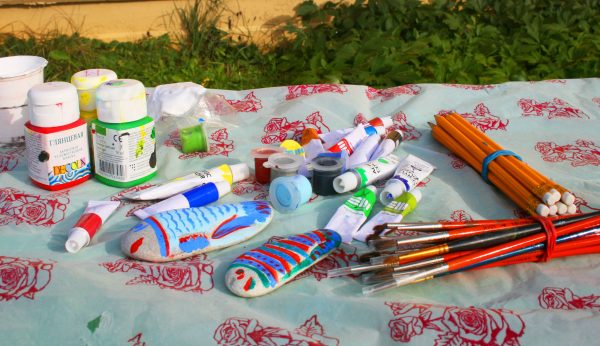
Lacquer
The final stage of the work is coating the stone with acrylic varnish after the entire surface has completely dried. The composition dries very quickly. This process enhances the brightness and depth of colors, gives the picture a spectacular look and glossy sheen. Paint under a varnish layer does not blur.
How to build a palette
To paint a small stone usually requires very little pigment. To avoid excessive consumption and drying of the dye in the tank, you need a palette. It is not recommended to use special means that stop the thickening: at the same time, some qualities of the paint are lost. Using the palette will make it possible to work slowly, without fear of drying out the material. It is permissible to squeeze the strictly necessary amount of paint onto it and add as needed.
The device is easily done with your own hands:
- Take a regular plastic container for food (size depends on the number of colors).
- Cover it with a napkin.
- Saturate it with water.
- Spread in this device a little paint of the desired shades.
to contents ↑After the completion or suspension of the painting, the homemade palette is covered with wax paper on top so that the moisture does not evaporate and the dye does not dry out. Some craftsmen put the container in the refrigerator. The work can be continued at any time, the paint will not disappear.
Painting sequence
The order of decorating stones involves a certain sequence of actions:
- creation of a sketch of a drawing on paper;
- thorough cleaning of the material for work;
- primer of a surface (white paint and PVA glue in a ratio of 1: 1);
- complete drying;
- drawing with a pencil the elements of the future drawing;
- layer-by-layer application of the corresponding colors of acrylic dyes;
- tracing the contours and details of the picture;
- coating with a transparent protective varnish.
The technique of painting is simple and accessible even to children.
to contents ↑What can be painted on the stone?
Depending on the artist’s imagination, any pebbles in the garden can turn into decoration of flower beds, paths, fences, as well as pointers, sculptural groups, a play area. Decorating with patterns emphasizes the features and structure of the artwork. Arrange compositions in any convenient corners of a garden. Fancy design art objects bring unique color to the landscape. The most spectacular compositions look:
- Strawberries - for their image you will need small rounded pebbles, ordinary tools, PVA glue, acrylic varnish and paints of red, green, black and white colors. The stone is primed, a background layer is applied on the back side, half is covered with red dye, green leaves are painted, after drying, make black and white lines on top of the first layer.
- A family of pebbles - is depicted on a large cobblestone, to which small oval-shaped stones are glued in a vertical position. Black and white dyes will be required. White eyes with black pupils are painted on miniature pebbles, varnished at the final stage.
- House - for it you need a rounded stone with a triangular base, black felt-tip pen, acrylic paints of violet, blue, white and yellow colors. After drawing a sketch with a pencil on the base, the roof is painted blue, the house itself is lilac, the windows are yellow, the doors are white. The contours of the drawing are outlined with a marker and varnished.
- Ladybug - is drawn on an oblong stone with black, white, red and orange colors. Following the transfer of the sketch to the base, the body of the insect is painted in scarlet color. A black stripe is drawn in the middle, dots are applied to the wings, the muzzle is painted white.
- Cute panda - it will require a stone of a flat shape, ordinary tools, paints of black, white and green shades. After transferring the sketch to the base, the body, legs, head and ears of the animal are painted in black and white, and the twig in the legs and grass are green.
- A frog - is depicted on a stone of the corresponding form with acrylic dyes: yellow, green, brown, white, black and golden. Yellow and green colors are mixed until a light shade is obtained. They draw the sides of the base, legs and tail of the amphibian. The body is painted green and outlined in black. Semicircles are drawn above the eyes, bordering them with white. Golden color is useful for the eyes.
- A charming hedgehog - for it you need a base of an oblong pointed shape and paint of white, gray, black, red and light brown tones. The muzzle and trunk of the hedgehog in the middle are light gray, and dark at the edges. Black draw a nose, needles, contour of the muzzle, paws and eyes. The needles are interspersed with white and brown strokes. The bag is painted over white with black shading and red dots.
- Owl - is drawn on an oblong stone. The body is painted with gray paint. Feathers and nose are drawn in black, on the face - a white shade. For pupils, a red and orange tone is used. About varnish is better not to forget.
- Unusual cacti - they are easy to draw on small and medium pebbles with green acrylic paint in different shades. The technology is very simple: the stains are stained, the needles are applied with the corrector and artificial cacti are placed in a sand pot, surrounded by small pebbles.
The stones painted with funny pictures look good on flowerbeds, along the edges of paths, in rock gardens. In addition to aesthetic purposes, such natural compositions perform an ecological function, replacing plastic jewelry. Material for artistic creation can be found right under your feet, you need to connect a drop of imagination and a few bright colors to it.

